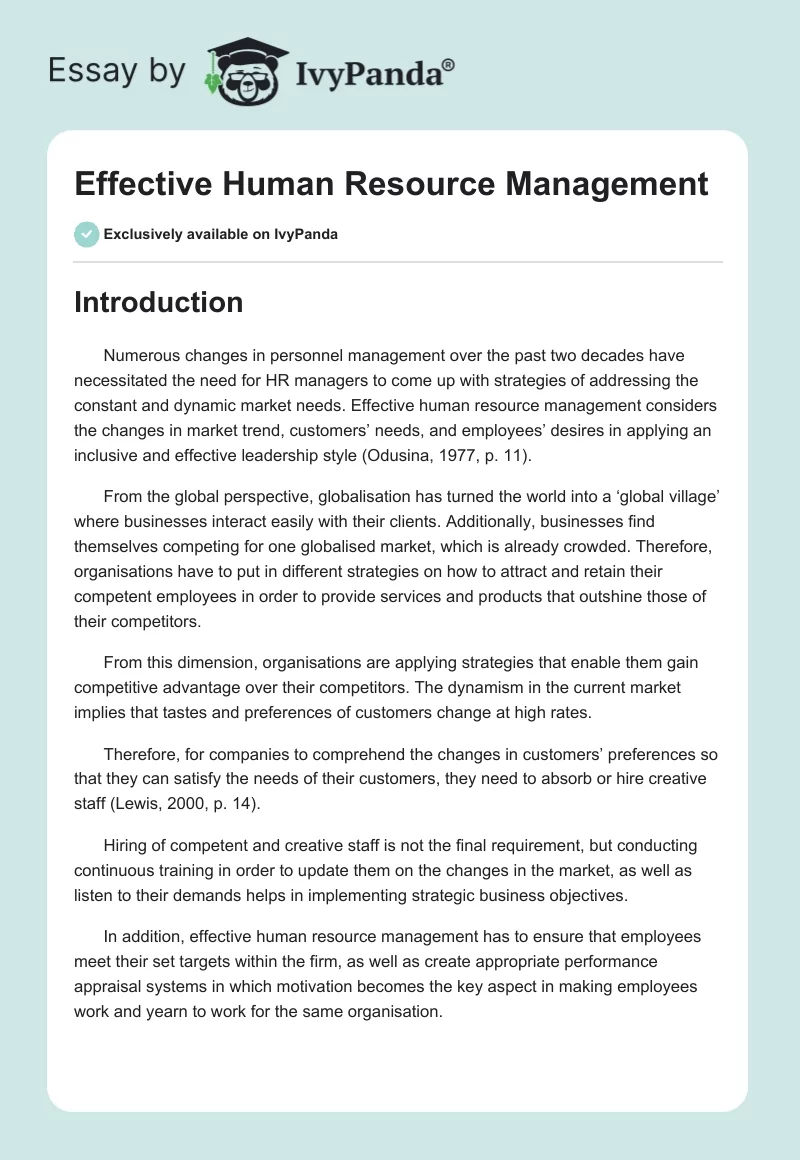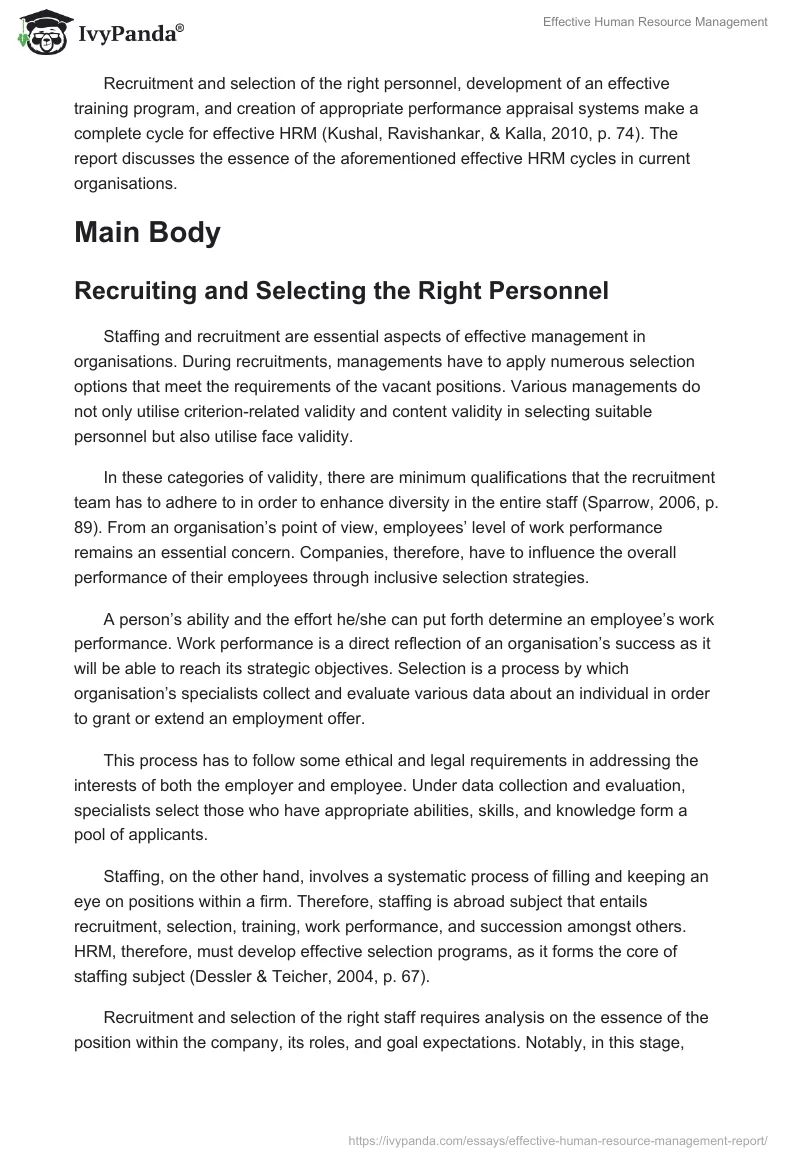Introduction
Numerous changes in personnel management over the past two decades have necessitated the need for HR managers to come up with strategies of addressing the constant and dynamic market needs. Effective human resource management considers the changes in market trend, customers’ needs, and employees’ desires in applying an inclusive and effective leadership style (Odusina, 1977, p. 11).
From the global perspective, globalisation has turned the world into a ‘global village’ where businesses interact easily with their clients. Additionally, businesses find themselves competing for one globalised market, which is already crowded. Therefore, organisations have to put in different strategies on how to attract and retain their competent employees in order to provide services and products that outshine those of their competitors.
From this dimension, organisations are applying strategies that enable them gain competitive advantage over their competitors. The dynamism in the current market implies that tastes and preferences of customers change at high rates.
Therefore, for companies to comprehend the changes in customers’ preferences so that they can satisfy the needs of their customers, they need to absorb or hire creative staff (Lewis, 2000, p. 14).
Hiring of competent and creative staff is not the final requirement, but conducting continuous training in order to update them on the changes in the market, as well as listen to their demands helps in implementing strategic business objectives.
In addition, effective human resource management has to ensure that employees meet their set targets within the firm, as well as create appropriate performance appraisal systems in which motivation becomes the key aspect in making employees work and yearn to work for the same organisation.
Recruitment and selection of the right personnel, development of an effective training program, and creation of appropriate performance appraisal systems make a complete cycle for effective HRM (Kushal, Ravishankar, & Kalla, 2010, p. 74). The report discusses the essence of the aforementioned effective HRM cycles in current organisations.
Main Body
Recruiting and Selecting the Right Personnel
Staffing and recruitment are essential aspects of effective management in organisations. During recruitments, managements have to apply numerous selection options that meet the requirements of the vacant positions. Various managements do not only utilise criterion-related validity and content validity in selecting suitable personnel but also utilise face validity.
In these categories of validity, there are minimum qualifications that the recruitment team has to adhere to in order to enhance diversity in the entire staff (Sparrow, 2006, p. 89). From an organisation’s point of view, employees’ level of work performance remains an essential concern. Companies, therefore, have to influence the overall performance of their employees through inclusive selection strategies.
A person’s ability and the effort he/she can put forth determine an employee’s work performance. Work performance is a direct reflection of an organisation’s success as it will be able to reach its strategic objectives. Selection is a process by which organisation’s specialists collect and evaluate various data about an individual in order to grant or extend an employment offer.
This process has to follow some ethical and legal requirements in addressing the interests of both the employer and employee. Under data collection and evaluation, specialists select those who have appropriate abilities, skills, and knowledge form a pool of applicants.
Staffing, on the other hand, involves a systematic process of filling and keeping an eye on positions within a firm. Therefore, staffing is abroad subject that entails recruitment, selection, training, work performance, and succession amongst others. HRM, therefore, must develop effective selection programs, as it forms the core of staffing subject (Dessler & Teicher, 2004, p. 67).
Recruitment and selection of the right staff requires analysis on the essence of the position within the company, its roles, and goal expectations. Notably, in this stage, diversity within the workforce can increase a firm’s productivity if it deals in cross-border activities, as diverse employees easily understand the different cultures of their clients.
For productivity, there ought to be benchmarks that a specific post in the company requires applicant to meet, and in the selection process, the HR ought to apply ethical standards in filling the vacant positions.
Discrimination in terms of race, nationality, ethnic group, gender, or religious affiliation should not arise; academic qualification and practical competency should be the only benchmarks in recruitment (Hancock, 2002, p. 30). For business owners, being at the top of the recruitment team enables them to get the right employees with the required skills to steer the organisation to high levels.
Even though recruitment and selection process does not guarantee success for businesses, activities at this stage help in hiring best talents who are able to learn new ideas and apply in their lines of duty in order to improve a firm’s image in the global arena.
With strong competition in the market, companies that recruit the talent that matches the needs of the market are highly likely to gain competitive advantage over their competitors.
Developing Effective Training Programmes
After hiring the best personnel, maintaining their productivity remains the key aspect for the HRM given changes in jobs and constant market fluctuations. In designing training programmes, the HR department must ensure that each training session produces positive impacts on the firm.
Development of a training manual follows a given criteria: performance of training needs assessment, designing of the programme, transfer of training, relapse prevention, and evaluation (Hughey, & Mussnug, 1997, p. 27). A training programme need not to waste money, but to increase an organisation’s overall productivity.
Careful planning of the training process helps to transfer skills, knowledge, attitudes and behaviours to perform specific functions in the workplace. According to Scullion (2011, p.37), talent management helps in motivating employees to learn new ideas, as well as remain clear on the objectives of the firm and their personal goals too.
An organisation has to provide right resources to embark on training employees to improve growth of both the firm and individual employees. HR departments in all organisations have to ensure that they bring out the best from the existing employees. Talent management engages and motivates critical talents within a firm, and directs them towards achieving the strategic goals of the firm.
With the inclusion of hiring, motivating, training, and retaining of employees under this subject, talent management is a broad process that encompasses compensation, management, learning and development, global human resources, talent acquisition, performance management, goal management, and succession management.
Employees who prove worthwhile to the organisation are retained for continuous growth of the business. As put forward by Douglas McGregor’s X and Y theory, the two categories of employees require managers to understand the diverse management options to instil morale in all employees (Bray, 2009, p. 40). Depending on an organisation’s culture, a manager can influence employees to behave in a certain way.
Most companies are working to recruit competent employees, but do little in terms of training and retaining in order to develop their talents. In expanding its presence in the global platform, Unilever hired new employees, and aligned its objectives with the global approach on employee services in order to register high performance levels.
From a cultural perspective, talent management becomes part of an organisational culture and strategy, such that it develops the skills and increases responsibility of employees. The aspect becomes a way of operation within firms, in which it optimises the performance of each employee in respect to the expected goals. With the economic recession of 2009, companies rely on lean staffs that are well conversant with their roles.
The shifting demographics in terms of age, gender, and race, the HR department must device an inclusive approach to attract and retain skilful employees who are ready to remain updated with the current information and trends in the marketplace (Bray, 2009, p. 42).
Organisations can assess the success of its global talent programme by analysing its historical aspects on hiring, retention, productivity, and competitiveness in the market. In a situation of hiring new employees, an organisation can analyse the level at which applicants increase their interest to be part of the company.
Since the talent management programmes develops employees’ knowledge bases, more employees will prefer to work for organisations that enhances their personal development. Training programmes that address the needs of employees tend to benefit an organisation. At the same time, the training modules should inculcate the company’s strategic goals and objectives in their pursuit for successful delivery.
Creating Appropriate Performance Appraisal Systems
To determine the success of a programme, an organization has to create an appropriate regular assessment criterion. A successful performance appraisal system outlines the modalities for promoting of employees. With clear job description, assessment on job performance enables employees to know what the organisation expects of them, thus guiding them to work towards meeting or even surpassing the targets (Rao, 2004, p. 120).
A clear performance appraisal system helps in solving the review process problem. With companies applying different compensation methods to motivate their employees, they ought to have an effective appraisal system that identifies good performers.
A good performance evaluation system enables employees to know the competencies and skills that they have to develop in order to be assured of high compensation and promotion. An effective appraisal system must mention the expectations of a position as in the job description, as well as offer constructive guidance in case an employee does not meet the goals.
Overall assessment, therefore, has to link with the job expectations as a way of motivating employees to improve their performance. Moreover, an appropriate performance appraisal system has to be objective, fair and easy to comprehend (Latham et al., 2008, p. 225). Apart from promoting fair evaluation, the system should connect to the job.
Consistency in evaluation times and basic evaluation criteria has to be part of an effective evaluation system. Supervisors have to make employees view the performance appraisal system as one that intends to improve their work performance, and not for punishing or condemning (Hartog & Verburg, 2004, p. 73).
Organisations that create an appropriate performance appraisal system register high returns on investment (ROI), as employees are able to know their work progress, as well as what they are expected to attain.
Conclusion
Effective human resource management is a multifaceted approach that requires the involvement of all stakeholders within an organisation. Clear modalities have to be in place to guide the selection and recruitment process in order to absorb the best among the applicants.
The dynamic nature of the current market also demands for constant training of employees in order to be at per with the needs of the customers, and gain competitive edge over their competitors. For proper compensation of well-performing workforce, an effective performance appraisal system is necessary.
References
Bray, T. (2009). The training design manual the complete practical guide to creating effective and successful training programmes (2nd ed.). London: Kogan Page.
Dessler, G., & Teicher, J. (2004). Recruitment & selection. Frenchs Forest, N.S.W.: Pearson Education Australia.
Hancock, C. (2002). Effective Recruitment And Selection. Legal Information Management, 2(02), 21-35.
Hartog, D. N., & Verburg, R. M. (2004). High Performance Work Systems, Organisational Culture and Firm Effectiveness. Human Resource Management Journal, 14(1), 55-78.
Hughey, A. W., & Mussnug, K. J. (1997). Designing Effective Employee Training Programmes. Training for Quality, 5(2), 52-57.
Kushal, K. B., Ravishankar, S., & Kalla, H. L. (2010). Perspectives for Effective Management (2nd ed.). New Delhi: Himalaya Pub. House.
Latham, G. P., Budworth, M., Yanar, B., & Whyte, G. (2008). The Influence of a Manager’s Own Performance Appraisal on the Evaluation of Others. International Journal of Selection and Assessment, 16(3), 220-228.
Lewis, G. (2000, December 10). To Keep Employees, Show Them You Care. The Boston Globe, p. 14.
Odusina, B. (1977). How To Design Effective Learning Programmes. Industrial and Commercial Training, 9(1), 10-16.
Rao, T. (2004). Performance management and appraisal systems HR tools for global competitiveness. New Delhi: Response Books, a division of Sage Publications.
Scullion, H. (2011). Global talent management. New York: Routledge.
Sparrow, P. (2006). International recruitment, selection, and assessment. London: Chartered Institute of Personnel and Development.


